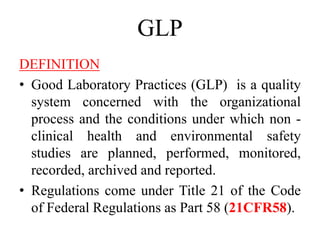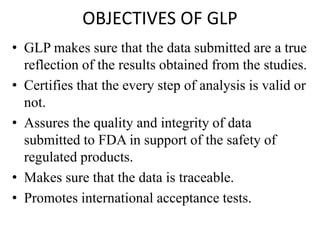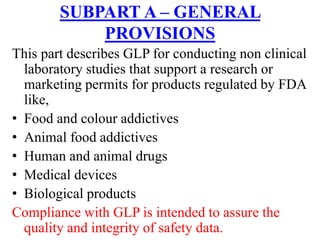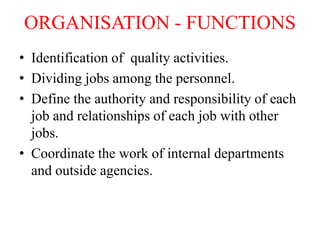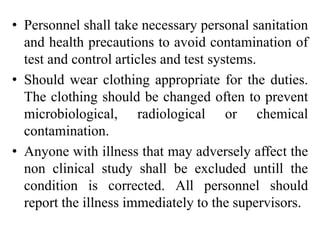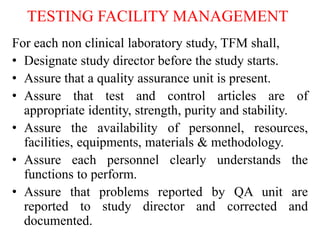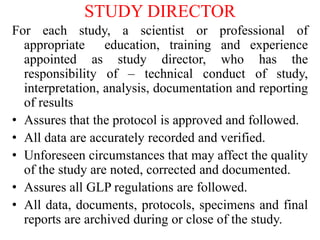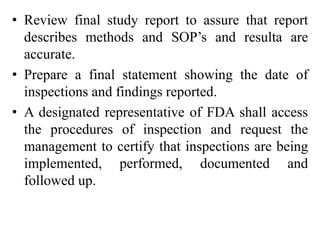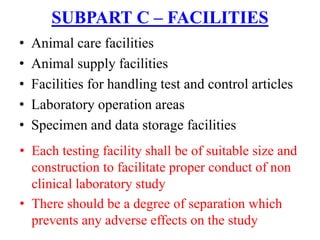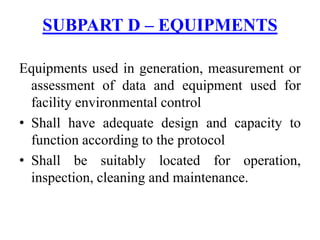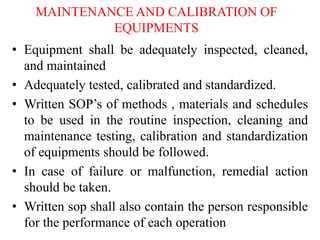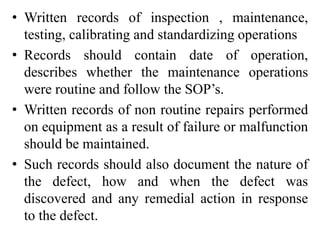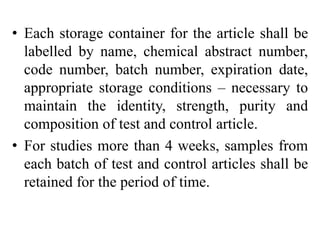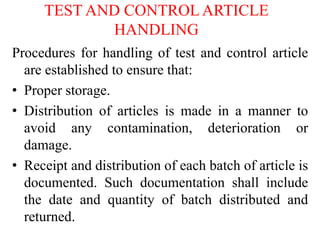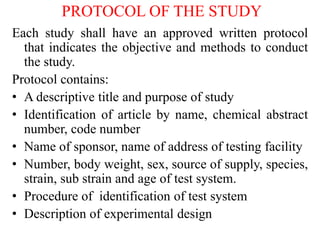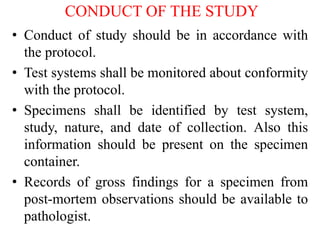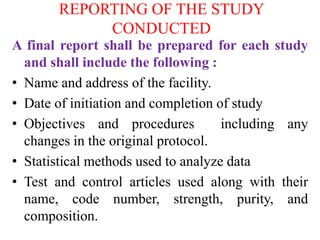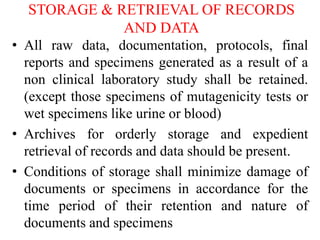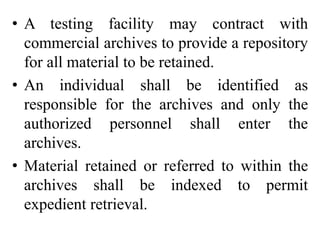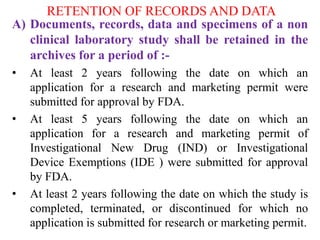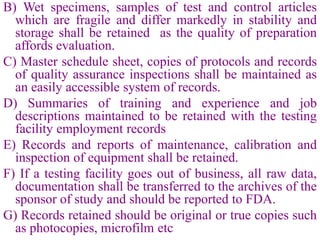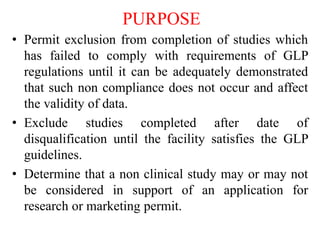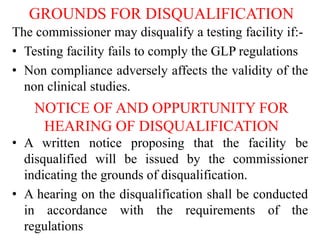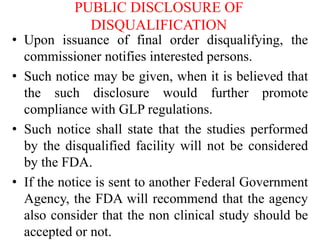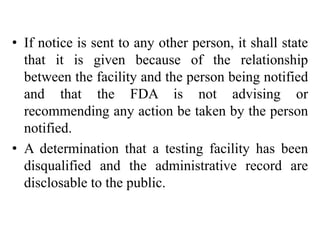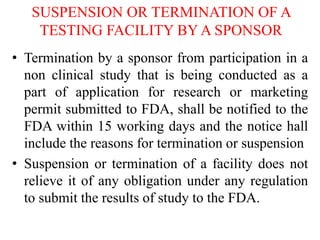GOOD LABORATORY PRACTICES - A DETAILED STUDY
- 1. Ms. TENY SARA THOMAS MOUNT ZION COLLEGE OF PHARMACEUTICAL SCIENCES AND RESEARCH, ADOOR, KERALA ASSISTANT PROFESSOR B.PHARM SIXTH SEMESTER PHARMACEUTICAL QUALITY ASSURANCE
- 2. GLP DEFINITION • Good Laboratory Practices (GLP) is a quality system concerned with the organizational process and the conditions under which non - clinical health and environmental safety studies are planned, performed, monitored, recorded, archived and reported. • Regulations come under Title 21 of the Code of Federal Regulations as Part 58 (21CFR58).
- 3. • GLP is an FDA regulation • A formal regulation that was created by the FDA in 1978. • In early 70’s poor laboratory practices were done • Discovered fraudulent activities and poor lab practices. • Examples were like equipments not calibrated, incorrect accounts, inadequate test systems, replacement of animals and fabrication of test results. • Hence creation of GLP.
- 4. NON CLINICAL STUDY • Conducted at a stage of medicine development that uses animals or cells and tissues to determine the safety of a medicine. • Does not involve humans. • Investigates the harmful effects of medicine on body such as, - toxic effects, if medicine causes genetic changes or any cancerous growth. • Also called pre-clinical studies.
- 5. OBJECTIVES OF GLP • GLP makes sure that the data submitted are a true reflection of the results obtained from the studies. • Certifies that the every step of analysis is valid or not. • Assures the quality and integrity of data submitted to FDA in support of the safety of regulated products. • Makes sure that the data is traceable. • Promotes international acceptance tests.
- 6. ADVANTAGES • Generation of high quality and reliable test data. • Increases public confidence • Shortens time to market new products. DISADVANTAGES • More man power is required. • Expensive process. • Time consuming process.
- 7. CONTENTS OF GLP SECTIONS CONTENTS SUBPART A GENERAL PROVISIONS SUBPART B ORGANISATION & PERSONNEL SUBPART C FACILITIES SUBPART D EQUIPMENT SUBPART E TESTING FACILITIES OPERATION SUBPART F TEST AND CONTROL ARTICLES SUBPART G PROTOCOL AND CONDUCT OF NON- CLINICAL LABORATORY STUDY SUBPART H RECORDS & REPORTS SUBPART I DISQUALIFICATION OF TESTING FACILITIES
- 8. SUBPART A – GENERAL PROVISIONS This part describes GLP for conducting non clinical laboratory studies that support a research or marketing permits for products regulated by FDA like, • Food and colour addictives • Animal food addictives • Human and animal drugs • Medical devices • Biological products Compliance with GLP is intended to assure the quality and integrity of safety data.
- 9. DEFINITIONS • Test article - any product mentioned by FDA meant for testing. • Control article – any product mentioned by FDA that is administered to the test system in the course of a non clinical laboratory study for the purpose of establishing a basis for comparison with test article. • Test system – means any product thereof to which the test or control article is administered or added for the study.
- 10. • Testing facilities – means a person or many establishment who actually conducts a non clinical study. The facility includes operational units used for the study. Person includes – individual, partnership, government agency etc. • Sponsor – a person who initiates and supports, by provision of financial or other resources, a non clinical study. They submit the report of the non clinical study to the FDA, in support of a research or marketing report.
- 11. • Study director – means the individual responsible for the overall conduct of a non clinical laboratory study. • Quality assurance unit - any person or organisation other except the study director, designated by the testing facility management to perform the duties relating to quality assurance of non clinical study.
- 12. • Raw data – is result of original observations and activities of the study and are necessary for the reconstruction and evaluation of the report. Raw data includes – • Lab worksheets, records, notes, memo • Photographs, computer printouts, magnetic media, recorded data from automated instruments. • When exact transcript of raw data have been prepared, the exact copy may be substituted for the original.
- 13. INSPECTION OF TESTING FACILITY – MAJOR GENERAL PROVISION • A testing facility shall permit an authorized employee of the FDA, to inspect the facility and inspect all records and specimens required to be maintained regarding studies. • Any testing facility refusing to permit inspection will be debarred or results will not be applicable.
- 14. • Personnel • Testing facility management • Study director • Quality assurance unit SUBPART B – ORGANISATION & PERSONNEL
- 15. ORGANISATION - FUNCTIONS • Identification of quality activities. • Dividing jobs among the personnel. • Define the authority and responsibility of each job and relationships of each job with other jobs. • Coordinate the work of internal departments and outside agencies.
- 16. PERSONNEL • Each individual engaged in a non clinical laboratory study shall have education, training and experience so that can perform the assigned functions. • Each testing facility should maintain a summary of training and experience and job description of each individual engaged in non clinical laboratory study. • Sufficient number of personnel for timely and proper conduct of study.
- 17. • Personnel shall take necessary personal sanitation and health precautions to avoid contamination of test and control articles and test systems. • Should wear clothing appropriate for the duties. The clothing should be changed often to prevent microbiological, radiological or chemical contamination. • Anyone with illness that may adversely affect the non clinical study shall be excluded untill the condition is corrected. All personnel should report the illness immediately to the supervisors.
- 18. TESTING FACILITY MANAGEMENT For each non clinical laboratory study, TFM shall, • Designate study director before the study starts. • Assure that a quality assurance unit is present. • Assure that test and control articles are of appropriate identity, strength, purity and stability. • Assure the availability of personnel, resources, facilities, equipments, materials & methodology. • Assure each personnel clearly understands the functions to perform. • Assure that problems reported by QA unit are reported to study director and corrected and documented.
- 19. STUDY DIRECTOR For each study, a scientist or professional of appropriate education, training and experience appointed as study director, who has the responsibility of – technical conduct of study, interpretation, analysis, documentation and reporting of results • Assures that the protocol is approved and followed. • All data are accurately recorded and verified. • Unforeseen circumstances that may affect the quality of the study are noted, corrected and documented. • Assures all GLP regulations are followed. • All data, documents, protocols, specimens and final reports are archived during or close of the study.
- 20. QUALITY ASSURANCE UNIT • Responsible for monitoring each study to assure that facilities, equipments, personnel, methods, practices, records comply with the regulations. • Maintain a copy of master schedule sheet of all the studies conducted which includes test article, nature of study, date of initiation of study, current status of the study, identity of the sponsor and name of study director. • Maintain copies of all protocols of the non clinical laboratory study. • Inspect each study at intervals to assure integrity of study
- 21. • Maintain written and signed records of each inspection with the date of inspection, phase of study, person performing inspection, findings and problems, action recommended and date for reinspection • Problems reported to study director and management. • Periodically submit reports study director and management. • Assures that no deviations from protocols and SOP’s are taken without approval.
- 22. • Review final study report to assure that report describes methods and SOP’s and resulta are accurate. • Prepare a final statement showing the date of inspections and findings reported. • A designated representative of FDA shall access the procedures of inspection and request the management to certify that inspections are being implemented, performed, documented and followed up.
- 23. • Animal care facilities • Animal supply facilities • Facilities for handling test and control articles • Laboratory operation areas • Specimen and data storage facilities SUBPART C – FACILITIES • Each testing facility shall be of suitable size and construction to facilitate proper conduct of non clinical laboratory study • There should be a degree of separation which prevents any adverse effects on the study
- 24. ANIMAL CARE FACILITIES • A testing facility should have sufficient number of animal rooms to assure proper – separation of species, isolation of individual projects, quarantine of animals, specialized housing of animals. • Should have sufficient number of animal rooms for studies being done with test or control articles known to be bio hazardous which includes volatile substances, radioactive materials, or infectious agents.
- 25. • Separate areas for diagnosis, treatment and control of laboratory animal diseases. Area provides effective isolation for housing of animals known or suspected of being diseased or being carriers of disease from other animals. • Facilities for collection and disposal of all animal waste or safe storage of waste before removal from testing facility. Disposal facilities should minimize vermin infestation, odours, disease hazards and environmental contamination.
- 26. ANIMAL SUPPLY FACILITIES • Storage areas needed for feed, bedding, supplies and equipment • Storage areas for feed and bedding shall be separated from the area of testing systems and protected from infestation and contamination LABORATORY OPERATION AREAS • Laboratory space provided for the performance of routine and specialized procedures required by non clinical laboratory studies. SPECIMEN AND DATA STORAGE FACILITIES • Space shall be provided for archives, limited access to authorised personnel, storage and retrieval of all raw data and specimens from completed studies.
- 27. FACILITIES FOR HANDLING TEST AND CONTROL ARTICLES A) To prevent contamination or mix-ups, there shall be separate areas for: • Receipt & storage of test and control articles • Mixing of test and control articles with a carrier • Storage of test and control article mixtures. B) Storage areas for test and control article and test and control mixtures shall be separate from areas housing the test systems • Facilities should preserve the identity, strength, purity, and stability of articles and moistures
- 28. Equipments used in generation, measurement or assessment of data and equipment used for facility environmental control • Shall have adequate design and capacity to function according to the protocol • Shall be suitably located for operation, inspection, cleaning and maintenance. SUBPART D – EQUIPMENTS
- 29. MAINTENANCE AND CALIBRATION OF EQUIPMENTS • Equipment shall be adequately inspected, cleaned, and maintained • Adequately tested, calibrated and standardized. • Written SOP’s of methods , materials and schedules to be used in the routine inspection, cleaning and maintenance testing, calibration and standardization of equipments should be followed. • In case of failure or malfunction, remedial action should be taken. • Written sop shall also contain the person responsible for the performance of each operation
- 30. • Written records of inspection , maintenance, testing, calibrating and standardizing operations • Records should contain date of operation, describes whether the maintenance operations were routine and follow the SOP’s. • Written records of non routine repairs performed on equipment as a result of failure or malfunction should be maintained. • Such records should also document the nature of the defect, how and when the defect was discovered and any remedial action in response to the defect.
- 31. • Standard Operating Procedures • Reagents and Solutions • Animal Care SUBPART E – TESTING FACILITIES OPERATION
- 32. STANDARD OPERATING PROCEDURES A) SOP’s shall be established for , • Animal room preparation • Animal care • Receipt, identification, storage, handling, mixing and method of sampling of test and control articles. • Test system operations • Laboratory test • Handling of animals found moribund or dead during the study. • Necropsy of animals or postmortem examination of animals. • Collection and identification of specimens • Histopathology • Data handling, storage, and retrieval • Maintenance and calibration of equipment • Transfer, proper placement and identification of animals
- 33. B) Each laboratory • Shall have laboratory manuals and SOP’s of the laboratory procedures being performed • Published literature can also be used as supplement of the SOP’s. C) A historical file of SOP’s and all its revisions including the dates of the revisions shall be maintained. D) A testing facility shall have SOP’s that the management is satisfied are adequate to ensure quality and integrity of data generated in the study. • All deviations from SOP’s shall be authorized by the study director and documented. • Significant changes in SOP’s should properly authorized in writing.
- 34. REAGENTS AND SOLUTIONS • All reagents and solutions in the laboratory areas shall be labelled to indicate identity, titre or concentration, storage requirements and expiration date. • Deteriorated or outdated reagents and solutions shall not be used.
- 35. ANIMAL CARE • SOP’s for housing, feeding, handling, and care of animals • All newly received animals from outside sources shall be isolated and their health status shall be evaluated with acceptable veterinary medical practice. • At the initiation of the study, animals shall be free of any disease or condition that may affect the study. • If during the course of study, animals contract any disease or condition, they should be isolated, treated. • Diagnosis, authorizations of treatment, description of treatment and each date of treatment shall be documented and retained.
- 36. • Animal cages, racks and accessory equipments shall be cleaned and sanitized at appropriate intervals. • Bedding used in animal cages or pens shall not interfere with the study and shall be changed often as necessary to keep the animals dry and clean. • If any pest control materials are used, the use shall be documented. Cleaning and pest control materials that interfere with study shall not be used. • Animals of different species shall be housed in separate rooms. Animals of same species but used in different studies should not be in same rooms as they may interfere the with the outcome of the study. If mixed housing is necessary, adequate differentiation by space and identification shall be made.
- 37. • Feed and water used for the animals shall be analysed periodically to ensure that the contaminants known to be capable of interfering the study and reasonably expected to be present in feed and water are not present at levels above those specified in protocol. • Warm blooded animals used in the study or in studies that require animals to be removed from and returned to their home cages for any reason (eg, cleaning, treatment) shall receive appropriate identification. All the information needed for identification shall appear outside the animal housing unit.
- 38. • Test and Control Article Characterization • Test and Control Article Handling • Mixture of Articles with Carriers SUBPART F – TEST AND CONTROL ARTICLES
- 39. TEST AND CONTROL ARTICLE CHARACTERIZATION • Identity, strength, purity and composition that defines the test and control article shall be determined and documented. • Methods of synthesis, fabrication, or derivation of test and control article shall be documented by sponsor and testing facility. • Stability of the article shall be determined : before the study or concomitantly according to the written SOP’s.
- 40. • Each storage container for the article shall be labelled by name, chemical abstract number, code number, batch number, expiration date, appropriate storage conditions – necessary to maintain the identity, strength, purity and composition of test and control article. • For studies more than 4 weeks, samples from each batch of test and control articles shall be retained for the period of time.
- 41. TEST AND CONTROL ARTICLE HANDLING Procedures for handling of test and control article are established to ensure that: • Proper storage. • Distribution of articles is made in a manner to avoid any contamination, deterioration or damage. • Receipt and distribution of each batch of article is documented. Such documentation shall include the date and quantity of batch distributed and returned.
- 42. MIXTURE OF ARTICLES WITH CARRIERS A) For each article that is mixed with a carrier, tests by appropriate analytical methods shall be conducted: • To determine the uniformity of mixture • To determine the concentration of each article in mixture. • To determine the stability of article in mixture before the study or concomitantly according to written SOP’s B) Date of the components of the test and control article carrier mixture should be clearly shown on the container. If more than one component is present the earlier expiry date should be shown.
- 43. • Protocol of the study • Conduct of the study SUBPART G – PROTOOLAND CONDUCT OF NON CLINICAL STUDY
- 44. PROTOCOL OF THE STUDY Each study shall have an approved written protocol that indicates the objective and methods to conduct the study. Protocol contains: • A descriptive title and purpose of study • Identification of article by name, chemical abstract number, code number • Name of sponsor, name of address of testing facility • Number, body weight, sex, source of supply, species, strain, sub strain and age of test system. • Procedure of identification of test system • Description of experimental design
- 45. • Description or identification of the diet used in the study • Description or identification of the solvents, emulsifiers or materials used to solubilise and suspend the test and control article before mixing with the carrier. • Description shall include specifications of acceptable level of contaminants that may interfere the study. • Type and frequency of test, analyses and measurements to be made. • Each dosage level, expressed in mg/kg of body weight of the article to be administered and its frequency. • Records to be maintained. Date of approval of protocol by the sponsor and signed with date of study director • All changes or revisions of approved protocol shall be documented, signed by study director.
- 46. CONDUCT OF THE STUDY • Conduct of study should be in accordance with the protocol. • Test systems shall be monitored about conformity with the protocol. • Specimens shall be identified by test system, study, nature, and date of collection. Also this information should be present on the specimen container. • Records of gross findings for a specimen from post-mortem observations should be available to pathologist.
- 47. • All data generated during the study shall be recorded directly in legible ink. Data entry shall be dated on the date of entry and signed by person entering data • Any changes in the entry should also be entered along with the reason of the change and the sign of the person entering the data • In automated data collection and any changes in the automated data collection along with the reason of change, the individual responsible for direct data input shall be identified at the time of data input.
- 48. • Reporting of non clinical laboratory study results. • Storage and retrieval of records and data • Retention of records SUBPART H – RECORDS AND REPORTS
- 49. REPORTING OF THE STUDY CONDUCTED A final report shall be prepared for each study and shall include the following : • Name and address of the facility. • Date of initiation and completion of study • Objectives and procedures including any changes in the original protocol. • Statistical methods used to analyze data • Test and control articles used along with their name, code number, strength, purity, and composition.
- 50. • Description of methods used • Description of test system • Number of animals used, sex, body weight range, source of supply, species, strain and sub strain, age and procedure of identification • Description of dosage, dosage regimen, route of administration, and duration • Description of circumstances that can affect the quality and integrity of the data • Name of study director, scientists and other professionals involved.
- 51. • Description of transformations, calculations, or operations performed on the data, a summary and analysis of the data • Signed and dated reports of each individual scientists • Locations where all specimens, raw data, and final report. • Final report to be signed and dated by the study director. • Corrections/additions to a final report shall be in the form of an amendment by the study director.
- 52. STORAGE & RETRIEVAL OF RECORDS AND DATA • All raw data, documentation, protocols, final reports and specimens generated as a result of a non clinical laboratory study shall be retained. (except those specimens of mutagenicity tests or wet specimens like urine or blood) • Archives for orderly storage and expedient retrieval of records and data should be present. • Conditions of storage shall minimize damage of documents or specimens in accordance for the time period of their retention and nature of documents and specimens
- 53. • A testing facility may contract with commercial archives to provide a repository for all material to be retained. • An individual shall be identified as responsible for the archives and only the authorized personnel shall enter the archives. • Material retained or referred to within the archives shall be indexed to permit expedient retrieval.
- 54. RETENTION OF RECORDS AND DATA A) Documents, records, data and specimens of a non clinical laboratory study shall be retained in the archives for a period of :- • At least 2 years following the date on which an application for a research and marketing permit were submitted for approval by FDA. • At least 5 years following the date on which an application for a research and marketing permit of Investigational New Drug (IND) or Investigational Device Exemptions (IDE ) were submitted for approval by FDA. • At least 2 years following the date on which the study is completed, terminated, or discontinued for which no application is submitted for research or marketing permit.
- 55. B) Wet specimens, samples of test and control articles which are fragile and differ markedly in stability and storage shall be retained as the quality of preparation affords evaluation. C) Master schedule sheet, copies of protocols and records of quality assurance inspections shall be maintained as an easily accessible system of records. D) Summaries of training and experience and job descriptions maintained to be retained with the testing facility employment records E) Records and reports of maintenance, calibration and inspection of equipment shall be retained. F) If a testing facility goes out of business, all raw data, documentation shall be transferred to the archives of the sponsor of study and should be reported to FDA. G) Records retained should be original or true copies such as photocopies, microfilm etc
- 56. • Purpose • Grounds for Disqualification • Notice of and opportunity for hearing on proposed disqualification. • Final order on disqualification • Actions upon disqualification • Public disclosure of information regarding disqualification • Alternative or additional actions on disqualification • Suspension or termination of testing facility by sponsor. • Reinstatement of a disqualified testing facility. SUBPART I – DISQUALIFIACTION OF TESTING FACILITY
- 57. PURPOSE • Permit exclusion from completion of studies which has failed to comply with requirements of GLP regulations until it can be adequately demonstrated that such non compliance does not occur and affect the validity of data. • Exclude studies completed after date of disqualification until the facility satisfies the GLP guidelines. • Determine that a non clinical study may or may not be considered in support of an application for research or marketing permit.
- 58. GROUNDS FOR DISQUALIFICATION The commissioner may disqualify a testing facility if:- • Testing facility fails to comply the GLP regulations • Non compliance adversely affects the validity of the non clinical studies. NOTICE OF AND OPPURTUNITY FOR HEARING OF DISQUALIFICATION • A written notice proposing that the facility be disqualified will be issued by the commissioner indicating the grounds of disqualification. • A hearing on the disqualification shall be conducted in accordance with the requirements of the regulations
- 59. FINAL ORDER ON DISQUALIFICATION • If the commissioner, after the hearing, and an evaluation of the records of disqualification, makes the findings and shall issue a final order disqualifying the facility. Such final order shall include a statement of basis of determination and notify the testing facility. • If the commissioner, after the regulatory hearing and an evaluation of the records of disqualification, does not make any findings and shall issue a final order terminating the disqualification. Such final order shall include a statement of basis of determination and notify the testing facility ad provide a copy.
- 60. ACTIONS UPON DISQUALIFICATION • Once a testing facility has been disqualified , any non clinical study conducted by the disqualified facility may be examined to determine whether such study would be essential. • If it is determined to be essential, the FDA shall also determine whether the study is acceptable, notwithstanding the disqualification of facility. • Any study presumed to be unacceptable, and the person relying on the study may be required to establish that the study was not affected by the circumstances that led to the disqualification, by submitting validating information.
- 61. • If study is determined to be unacceptable, such data will be eliminated and such elimination may serve as new information justifying the termination or withdrawal of approval of application. • No nonclinical study begun by a facility after the date of disqualification shall be considered in support of application for research or marketing permit unless the facility has been reinstated. • The determination that a study may not be considered in support of an application does not relieve the applicant for a permit of any obligation under any regulation to submit the results of the study to the FDA.
- 62. PUBLIC DISCLOSURE OF DISQUALIFICATION • Upon issuance of final order disqualifying, the commissioner notifies interested persons. • Such notice may be given, when it is believed that the such disclosure would further promote compliance with GLP regulations. • Such notice shall state that the studies performed by the disqualified facility will not be considered by the FDA. • If the notice is sent to another Federal Government Agency, the FDA will recommend that the agency also consider that the non clinical study should be accepted or not.
- 63. • If notice is sent to any other person, it shall state that it is given because of the relationship between the facility and the person being notified and that the FDA is not advising or recommending any action be taken by the person notified. • A determination that a testing facility has been disqualified and the administrative record are disclosable to the public.
- 64. ALTERNATIVE OR ADDITIONALACTIONS TO DISQUALIFICATION • The FDA can refuse to consider a study for the application of research or marketing permit, if it finds that the study was not conducted in accordance with the regulations of GLP, without disqualifying the testing facility that conducted the study. • The FDA may initiate judicial proceedings(civil or criminal) against the testing facility or sponsor of a non clinical laboratory study simultaneously or subsequently with disqualification.
- 65. SUSPENSION OR TERMINATION OF A TESTING FACILITY BY A SPONSOR • Termination by a sponsor from participation in a non clinical study that is being conducted as a part of application for research or marketing permit submitted to FDA, shall be notified to the FDA within 15 working days and the notice hall include the reasons for termination or suspension • Suspension or termination of a facility does not relieve it of any obligation under any regulation to submit the results of study to the FDA.
- 66. REINSTATEMENT OF DISQUALIFIED FACILITY • If a testing facility wishes to be reinstated, they shall present a writing to the commissioner reasons why it believes to be reinstated and a detailed description of the corrective actions taken to assure there is no reason for disqualification anymore. • The commissioner evaluates the submission, and ensures that the testing facility will conduct future studies in compliance with the regulations of GLP, and if any studies are being conducted, that the quality and integrity is not compromised. • If a testing facility is reinstated, the commissioner shall notify the facility and all other organisations which were reported about the disqualification.

